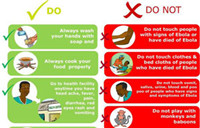Ebola facts: origin, spread and myths
By Faisal Kidwai (chinadaily.com.cn) Updated: 2014-10-20 11:33
|
 Quarantine workers at Qingdao airport in Shandong province test samples for the Ebola virus on Aug 11, 2014.[Xie Hao/For China Daily]
|
Ebola is the most dangerous virus the world has known since the outbreak of Severe Acute Respiratory Syndrome pandemic in 2003.
To help the global community deal with the crisis, China has announced a shipment of several thousand doses of an experimental drug to Africa along with millions of dollars in aid to the continent.
|
 |
|
 |
|
Chinese medical supplies arrive in Ebola-affected Sierra Leone |
Although there hasn't been any confirmed case of the disease in China yet, the country's National Health and Family Planning Commission has taken steps, such as reaching out to regional hospitals, maintaining a database and designating hospitals, to ensure Ebola does not get out of hand.
The outbreak has been dominating global headlines for months, but the focus has been more on sensational news and panic-inducing announcements than on the history of the disease, causes and what preventive measures people can take.
Given the paucity of authoritative information, it's no surprise that myths, distortions and conspiracies are now fuelling the debate and in the process causing more confusion.
Origin
Ebola was first discovered in 1976 near the Ebola River in what is now the Democratic Republic of the Congo. After making its first appearance nearly 40 years ago, the virus continued to infect people sporadically.
According to the World Health Organization (WHO), 1,716 confirmed cases were reported between 1976 and 2013. The first person to be identified with the virus was a storekeeper in a cotton factory in a region now known as South Sudan. He died within a week of being hospitalized.
The second reported case was a village school headmaster in the Democratic Republic of the Congo. He began displaying symptoms after visiting the Ebola River and died within 14 days. After his death, others who had been in contact with him also began dying, setting off such panic in the village that the government had to declare the whole area a quarantine zone for two weeks. Since then the virus has claimed hundreds of lives in several African countries.
Transmission
While fruit bats are natural Ebola virus hosts, the human population is infected when it comes into contact with the blood, secretions, organs or other bodily fluids of infected animals, such as chimpanzees, gorillas, fruit bats, monkeys, forest antelope and porcupines, found ill or dead or in the rainforest, according to the WHO.
Both animals and humans can catch the disease if they eat food the bat has dribbled or defecated on, or touch their eyes or mouth after touching a surface covered in infected bat droppings. It also spreads among people through direct contact with bodily fluids, such as semen, breast milk, blood, saliva, bedding, clothing, etc.
Patients can remain infected as long as their blood and body fluids carry the virus. Men can transmit the disease through semen for up to seven weeks after making a full recovery from the illness. The current outbreak though has been traced to a village in Guinea where bat hunting is common, said Doctors Without Borders.
Symptoms
It takes anywhere from two to 21 days for humans to display characteristics of the disease. A person cannot infect others until the onset of symptoms. Initially, the patient experiences a headache, fever, muscle pain and sore throat. It is followed by diarrhea and vomiting. In some cases, rashes may also appear.










